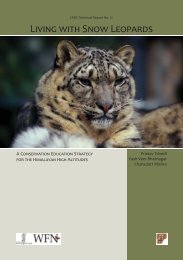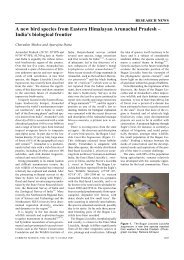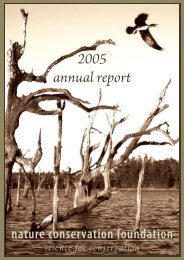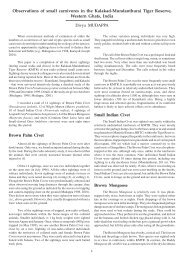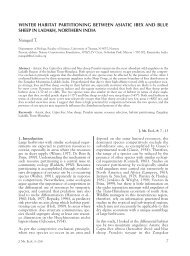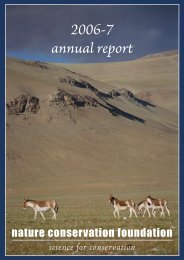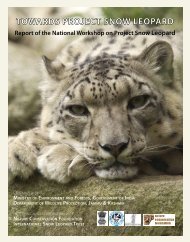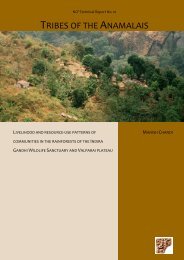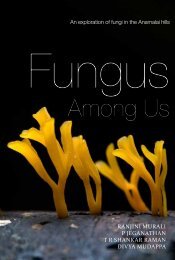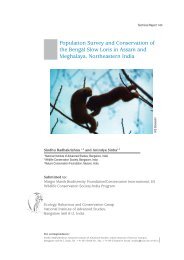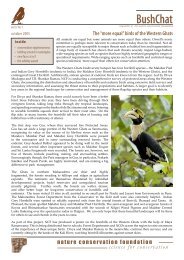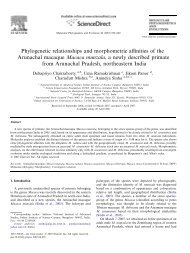Joshi Mudappa Raman - Nature Conservation Foundation
Joshi Mudappa Raman - Nature Conservation Foundation
Joshi Mudappa Raman - Nature Conservation Foundation
Create successful ePaper yourself
Turn your PDF publications into a flip-book with our unique Google optimized e-Paper software.
Biol Invasions (2009) 11:2387–2400<br />
DOI 10.1007/s10530-009-9423-6<br />
ORIGINAL PAPER<br />
Brewing trouble: coffee invasion in relation to edges<br />
and forest structure in tropical rainforest fragments<br />
of the Western Ghats, India<br />
Atul Arvind <strong>Joshi</strong> Æ Divya <strong>Mudappa</strong> Æ<br />
T. R. Shankar <strong>Raman</strong><br />
Received: 25 December 2007 / Accepted: 7 January 2009 / Published online: 21 January 2009<br />
Ó Springer Science+Business Media B.V. 2009<br />
Abstract While the conservation impacts of invasive<br />
plant species on tropical biodiversity is widely<br />
recognised, little is known of the potential for<br />
cultivated crops turning invasive in tropical forest<br />
regions. In the Western Ghats biodiversity hotspot,<br />
India, fragmented rainforests often adjoin coffee<br />
plantations. This study in the Anamalai hills assessed<br />
the effects of distance from edges and forest structure<br />
on the occurrence and abundance of shade-tolerant<br />
coffee (Arabica Coffea arabica and Robusta<br />
C. canephora) in four fragments (32–200 ha) using<br />
replicate line transects laid from the edges into the<br />
interiors. The coffee species cultivated in adjoining<br />
plantations was more abundant than the other coffee<br />
species inside study fragments, showing a clear<br />
decline in stem density from edge (0 m) to interior<br />
(250 m), suggesting the influence of propagule<br />
pressure of adjoining plantations, coupled with edge<br />
effects and seed dispersal by animals. Significant<br />
positive correlations of coffee density with canopy<br />
cover indicate the potential threat of coffee invasion<br />
A. A. <strong>Joshi</strong> (&) D. <strong>Mudappa</strong> T. R. S. <strong>Raman</strong><br />
<strong>Nature</strong> <strong>Conservation</strong> <strong>Foundation</strong>, 3076/5, IV Cross,<br />
Gokulam Park, Mysore 570002, India<br />
e-mail: atul@ncf-india.org<br />
T. R. S. <strong>Raman</strong><br />
e-mail: trsr@ncf-india.org<br />
A. A. <strong>Joshi</strong><br />
Forest Research Institute, I.P.E. Kaulagarh Road,<br />
Dehradun 248195, India<br />
even in closed canopy rainforests. Stem density of<br />
Coffea arabica (150–1,825 stems/ha) was higher in<br />
more disturbed fragments, whereas Coffea canephora<br />
had spread in disturbed and undisturbed sites achieving<br />
much higher densities (6.3–11,486 stems/ha). In<br />
addition, a negative relationship between C. canephora<br />
and native shrub density indicates its potential<br />
detrimental effects on native plants.<br />
Keywords Fragmentation Plantations<br />
Shade tolerance Invasive alien species<br />
Anamalai hills Coffea arabica Coffea canephora<br />
Introduction<br />
Human activities such as deforestation for plantations<br />
of economically important crops, logging, and developmental<br />
activities have resulted in widespread<br />
fragmentation of tropical rainforests, with resulting<br />
loss and alteration of biological diversity (Laurance<br />
et al. 1997; Benitez-Malvido and Martinez-Ramos<br />
2003). Major consequences of tropical forest fragmentation<br />
include changes in the extent and configuration<br />
of natural and altered habitats in the landscape,<br />
increased isolation of forest populations, increased<br />
edge effects, and invasions by non-indigenous species,<br />
all of which can have deleterious impacts on native<br />
biological diversity (Laurance et al. 1997; Denslow<br />
et al. 2001; Sakai et al. 2001). The sharp increase in the<br />
123
2388 A. A. <strong>Joshi</strong> et al.<br />
amount of edge following fragmentation, in particular,<br />
may negatively affect many mature forest species and<br />
ecological processes. Studies have shown that the<br />
artificial edges created by forest fragmentation create<br />
favourable conditions for the appearance of invasive<br />
alien species (Denslow et al. 2001; Fine 2002).<br />
According to the World <strong>Conservation</strong> Union (IUCN),<br />
the potential damage by invasive species to native<br />
species and ecosystems on a global scale is considered<br />
as important as the impact due to habitat degradation<br />
making it a serious conservation issue (IUCN 2000;<br />
Soulé and Orians 2001).<br />
Earlier studies have shown significant changes in<br />
biological diversity and increased prevalence of<br />
invasive species at or near forest fragment edges<br />
(Saunders et al. 1991; Sisk and Margules 1993). This<br />
may be linked to disturbance and edge-related microclimatic<br />
changes such as increase in temperature and<br />
light and reduction in humidity in fragments (Saunders<br />
et al. 1991; Laurance 2000). In addition, variables of<br />
forest structure and surrounding landscape matrix may<br />
also influence the distribution of non-indigenous<br />
species (Whitmore 1997; Denslow et al. 2001). Within<br />
fragments, disturbances such as canopy openings and<br />
changes to the soil surface may also enhance the<br />
likelihood of establishment of light-demanding or<br />
disturbance-adapted invasive alien species (Whitmore<br />
1997; Denslow et al. 2001; McNeely et al. 2001).<br />
The rainforests in the Western Ghats of India, a hill<br />
range recognised as a global biodiversity hotspot<br />
(Mittermeier et al. 2004), face threats similar to those<br />
faced by tropical forests in other parts of the world.<br />
Much of the Western Ghats rainforests now exists as<br />
fragments surrounded by plantations, mostly of nonindigenous<br />
plant species such as coffee (Coffea spp.),<br />
Eucalyptus, and tea (Kumar et al. 2004). Studies in one<br />
such fragmented landscape, the Valparai plateau in the<br />
Anamalai hills, have indicated the occurrence of nonindigenous<br />
species in many rainforest fragments<br />
(Muthuramkumar et al. 2006; <strong>Mudappa</strong> and <strong>Raman</strong><br />
2007). These include two species of coffee (Arabica<br />
Coffea arabica and Robusta C. canephora) that are<br />
shade-tolerant tropical understorey crops, Maesopsis<br />
eminii, an African tree species used as shade tree in<br />
coffee plantations, and other understorey weeds common<br />
in tropical south and south-east Asia such as<br />
Lantana camara and Chromolaena odorata.<br />
The need to assess coffee as a potential invasive in<br />
tropical forests becomes significant because, globally,<br />
123<br />
around 11 million hectares are under coffee cultivation,<br />
almost entirely in tropical forest regions (Clay 2004).<br />
With an annual value of over $100 billion, coffee is<br />
also the second highest traded commodity in international<br />
trade after oil, making assessment of its impacts<br />
on biodiversity an imperative (Donald 2004). Clearing<br />
new areas of tropical forest for coffee cultivation has<br />
also been a matter of recent conservation concern<br />
(Rappole et al. 2003). Frequently, coffee plantations<br />
adjoin protected conservation reserves or contain<br />
embedded forest remnants known to be significant for<br />
conservation of biological diversity (Somarriba et al.<br />
2004). Considerable recent research has addressed the<br />
biodiversity values of coffee plantations, especially<br />
shade-grown coffees (Rappole et al. 2003; Mas and<br />
Dietsch 2004), and the economic benefits of biodiversity<br />
to coffee farms (Ricketts et al. 2004;Philpottetal.<br />
2007). However, little attention has been paid on the<br />
effects of coffee plantations on adjoining tropical<br />
forests. A study in New South Wales has reported the<br />
spread of coffee (C. arabica) as a weed inside<br />
rainforest fragments and noted its potential threat to<br />
rainforest regeneration (Lymburner et al. 2006).<br />
This study was designed to assess the distribution<br />
and abundance of coffee species in relation to the<br />
distance from fragment edges and forest structural<br />
variables in tropical rainforest fragments on the<br />
Valparai plateau. We also compared the patterns of<br />
distribution and abundance of the two major coffee<br />
species, C. arabica and C. canephora. The results are<br />
discussed in the context of the potential for a widelycultivated<br />
crop to spread as an invasive and thereby<br />
affect tropical forest conservation.<br />
Materials and methods<br />
Study area<br />
The Western Ghats is a chain of mountains running<br />
almost parallel to the west coast of India from 7° to<br />
21° N. The 1600 km stretch is interrupted only by the<br />
30 km wide Palghat gap (11° N). High levels of<br />
biodiversity and endemism are its prominent characteristics,<br />
with about 5,000 flowering plant species, of<br />
which 1,700 species are endemic (Kumar et al. 2004).<br />
The forests of the Western Ghats include representative<br />
non-equatorial tropical wet evergreen forests of<br />
high conservation priority (Menon et al. 2001). This
Brewing trouble 2389<br />
region, along with Sri Lanka, has been recognised as<br />
a global biodiversity hotspot (Kumar et al. 2004).<br />
The Anamalai hill range, located to the south of the<br />
Palghat gap, had one of the largest contiguous tracts of<br />
tropical rainforest in the Western Ghats until the midnineteenth<br />
century. It was extensively clear-felled<br />
between the 1860s and 1930s for cultivation of tea and<br />
coffee, and later for teak and Eucalyptus plantations<br />
(Congreve 1942; Muthiah 1993). The establishment of<br />
plantations in addition to other forces of landscape<br />
change such as roads, hydroelectric dams, reservoirs,<br />
and logging led to fragmentation of the rainforest. As a<br />
consequence, the majority of the rainforest in the<br />
region today is comprised of approximately 40<br />
fragments, varying in area from 1 to 2,500 ha. These<br />
fragments are often surrounded by monoculture plantations,<br />
particularly by tea Camellia sinensis, amidst a<br />
human population of around 100,000 people on the<br />
Valparai plateau (<strong>Mudappa</strong> and <strong>Raman</strong> 2007).<br />
The Valparai plateau at 700–1,400 m above sea<br />
level is surrounded by Indira Gandhi Wildlife Sanctuary<br />
and National Park (987 km 2 ,10°12 0 –10°35 0 N<br />
and 76°49 0 –77°24 0 E) in Tamil Nadu and other<br />
protected areas and reserved forests in Kerala<br />
(Fig. 1). Extensive areas of private plantations of<br />
tea (150 km 2 ), coffee (28 km 2 ), cardamom (7 km 2 ),<br />
and Eucalyptus spread over an area of 220 km 2 on the<br />
Valparai plateau (Thomas 2003; <strong>Mudappa</strong> and<br />
<strong>Raman</strong> 2007). The natural vegetation of this region<br />
is mid-elevation tropical wet evergreen forest of the<br />
Cullenia exarillata–Mesua ferrea–Palaquium ellipticum<br />
type (Pascal 1988). The average annual rainfall<br />
Fig. 1 Map of the Indira<br />
Gandhi Wildlife Sanctuary<br />
(continuous line) indicating<br />
plantations on the Valparai<br />
plateau (within dashed<br />
lines) and surrounding<br />
protected areas. Rainforest<br />
fragments in the region are<br />
shown (grey) with<br />
fragments where the study<br />
was carried out indicated by<br />
arrows (MB Manamboli,<br />
PA Pannimade, PU<br />
Puthuthottam, TF Tata<br />
Finlay)<br />
recorded at Injipara estate of Valparai plateau over<br />
a period of 10 years (1989–1998) was 3,497 mm. The<br />
southwest monsoon (June–September) contributes<br />
about 70% of the total rainfall. The daytime temperature<br />
ranges between 19 and 24°C.<br />
The rainforest fragments on the Valparai plateau<br />
are located close to human settlements and are<br />
degraded due to fuel wood collection and felling for<br />
timber and a few have been partly under-planted with<br />
coffee or cardamom in the past and then abandoned.<br />
Most of the large fragments ([200 ha) are protected<br />
within the Indira Gandhi Wildlife Sanctuary (<strong>Mudappa</strong><br />
and <strong>Raman</strong> 2007).<br />
Intensive study sites<br />
The study was carried out between April and June<br />
2006. The study sites were selected on the basis of a<br />
preliminary survey that was carried out to broadly<br />
assess the disturbance levels of the fragments and the<br />
surrounding landscape. We selected four sites that<br />
adjoined coffee plantations and varied in area and<br />
degree of disturbance based on our prior research<br />
and familiarity with the area over the last decade<br />
(<strong>Mudappa</strong> and <strong>Raman</strong> 2007). Degree of disturbance<br />
was semi-quantitatively assessed by summing scores<br />
assigned for disturbance factors such as illegal timber<br />
felling, girdling, fuel-wood collection, past logging,<br />
presence of enclaves, hunting, incidence of fire and<br />
livestock grazing (for details, see Muthuramkumar<br />
et al. 2006; <strong>Mudappa</strong> and <strong>Raman</strong> 2007). Three of the<br />
selected sites were privately-owned rainforest<br />
123
2390 A. A. <strong>Joshi</strong> et al.<br />
Fig. 2 Boundary between coffee plantation and rainforest<br />
fragment, Tata Finlay (above); Robusta coffee (C. canephora)<br />
growing in the understorey of the protected site, Manamboli<br />
(below, photo courtesy: Kalyan Varma)<br />
fragments, two of which were adjacent to C. arabica<br />
plantation: Pannimade (less disturbed, 87 ha) and<br />
Tata Finlay (moderately disturbed, 32.6 ha). The third<br />
fragment, Puthuthottam (highly disturbed, 92 ha), was<br />
adjacent to abandoned plantations of C. arabica<br />
and C. canephora. In addition, we selected a relatively<br />
undisturbed site, the Manamboli rainforest<br />
fragment within the Indira Gandhi Wildlife Sanctuary<br />
(referred to as protected site, 200 ha), which adjoins a<br />
C. canephora plantation (Fig. 1). As a part of the<br />
Wildlife Sanctuary, this fragment has legal protection<br />
under the Wildlife Protection Act since 1976. This<br />
forest fragment is relatively undisturbed compared to<br />
all other privately owned rainforest fragments (Muthuramkumar<br />
et al. 2006). All sites had a clear boundary<br />
with coffee plantations and were found to have coffee<br />
established in the rainforest understorey (Fig. 2).<br />
The less disturbed (Pannimade) rainforest fragment<br />
contains fairly undisturbed tropical evergreen forest<br />
vegetation, but with a portion containing degraded<br />
123<br />
secondary vegetation under scattered plantation of<br />
Eucalyptus trees. A perennial stream separates the<br />
coffee plantation from the fragment. The Sholayar<br />
reservoir limits the fragment on two sides. The moderately<br />
disturbed fragment (Tata Finlay), the smallest<br />
among the four sites, is limited by the reservoir on one<br />
side and coffee and Eucalyptus plantation on the other<br />
sides, with a clear border between the coffee plantation<br />
and the fragment. The highly disturbed rainforest<br />
fragment (Puthuthottam) is surrounded by tea estates<br />
on two sides, C. arabica plantation on one side (poorly<br />
maintained and mostly abandoned) and abandoned<br />
plantation of C. canephora on the other side. The<br />
C. arabica plantation was planted with Maesopsis<br />
eminii (a non-indigenous species of African origin) as a<br />
shade tree along with other species such as Erythrina<br />
sp. and Artocarpus heterophyllus. The abandoned<br />
C. canephora plantation contained mainly mixed<br />
native tree species canopy. This fragment also has<br />
substantial naturally-regenerated Maesopsis eminii<br />
trees, especially along the C. arabica edge; this species<br />
has been noted to be invasive in forests (Cordeiro et al.<br />
2004). The fragment is highly disturbed due to high<br />
fuel-wood collection and its proximity to the Valparai<br />
town. The protected site (Manamboli) contains an<br />
estate enclave (an estate located within the boundary<br />
of wildlife sanctuary) with an extensive area under<br />
C. canephora forming a clear border with the fragment.<br />
Study plant species<br />
Arabica coffee (C. arabica) and robusta coffee<br />
(C. canephora) are the two major coffee species under<br />
cultivation, originating from Africa (Clay 2004).<br />
Arabica is a native understorey species of Ethiopian<br />
tropical forests growing at elevations between 1,600<br />
and 2,800 m in its native range (DaMatta 2004).<br />
Robusta coffee grows as a native mid-storey tree in<br />
its native range in the dense equatorial forests of the<br />
Congo basin between sea level and 1,200 m (DaMatta<br />
2004). While arabica is cultivated at elevations of<br />
500–2,000 m in different parts of the world (Clay<br />
2004), it is mostly grown between 1,000 and 1,500 m<br />
in India (Peter 2002). Robusta is generally cultivated<br />
at elevations below 1,000 m (Clay 2004; Peter 2002).<br />
The montane origin of arabica as compared to the<br />
lowland origin of robusta translates into key differences<br />
between the two species in terms of their<br />
ecology and requirements for cultivation. Arabica, in
Brewing trouble 2391<br />
comparison with robusta, requires lower optimum<br />
temperature (18–21°C vs. 22–30°C), lower humidity<br />
(70–80% vs. 80–90%), and is cultivated on gentle to<br />
moderate slopes whereas robusta is cultivated on<br />
gentle slopes to fairly level lands (Peter 2002;<br />
DaMatta 2004). Shade requirements also differ, with<br />
arabica generally requiring more shade (medium to<br />
light shade) as compared to uniformly thin shade for<br />
robusta (Peter 2002; DaMatta 2004). Given this<br />
requirement, arabica tends to be shade-grown while<br />
robusta is grown under full-sun, although varieties of<br />
arabica that tolerate full-sun and of robusta that can<br />
grow in shade are also known (Clay 2004; DaMatta<br />
2004). Studies have indicated that coffee grown in full<br />
sun tends to have yields that alternate between years of<br />
high and low yield resulting in a biennial production<br />
pattern (DaMatta 2004), while coffee grown under<br />
shade has more sustained annual yields (DaMatta<br />
2004) as well as greater vegetative growth (van Kanten<br />
and Vaast 2006). As arabica is a smaller shrub than<br />
robusta, it is generally planted at closer spacing<br />
resulting in higher densities of c. 3,000–4,000 stems/ha<br />
in plantations when compared to robusta (750–1,000<br />
stems/ha) in southern India. Yields of the two species<br />
typically range between 1,000 and 1,500 kg/ha for<br />
arabica and 1,300 and 2,000 kg/ha for robusta. Thus,<br />
individual robusta plants may produce over four times<br />
more fruits than individual arabica plants (A. Savarkar<br />
and B. P. <strong>Mudappa</strong>, personal communications). From<br />
the perspective of invasion potential, this suggests<br />
that robusta is likely to produce a higher number of<br />
seeds per hectare and a much higher number of seeds<br />
per individual than arabica plantations/individuals.<br />
The fruit type of both the coffee species is drupe of<br />
10–12 cm diameter. Each fruit typically contains<br />
two seeds (coffee beans). Coffee seeds are known to<br />
be dispersed by mammals; in the study area the main<br />
dispersers of coffee are the brown palm civet Paradoxurus<br />
jerdoni, Asian elephant Elephas maximus,<br />
lion-tailed macaque Macaca silenus, and sloth bear<br />
Melursus ursinus (<strong>Mudappa</strong> 2001; Muthuramkumar<br />
et al. 2006).<br />
Vegetation sampling<br />
In each fragment under study, vegetation was sampled<br />
systematically and uniformly using quadrats distributed<br />
along replicate line transects. Starting from the edge of<br />
the fragment adjoining the coffee plantation into the<br />
interior, line transects were marked in a direction<br />
perpendicular to the edge. In each fragment, seven line<br />
transects were marked, spaced 60 m apart from and<br />
parallel to each other. Along each line transect, 12<br />
quadrats of size 10 m 9 10 m were laid. The first<br />
quadrat was marked at the fragment edge and the next<br />
nine quadrats were laid 10 m apart from each other<br />
along the line transect. The 11th and 12th quadrats were<br />
laid at intervals of 25 m. In the four corners of each<br />
10 m 9 10 m quadrat, 2 m 9 2 m sub-quadrats were<br />
laid to count stems of native shrubs, coffee, Clerodendrum<br />
viscosum (a native pioneer shrub to large tree) and<br />
other focal plant species (data not included here). All<br />
stems that were at least 30 cm in height or with girth at<br />
breast height (GBH, 1.3 m) [1 cmand\30 cm were<br />
counted in these sub-quadrats.<br />
In each 10 m 9 10 m quadrat, canopy cover, canopy<br />
overlap, number of vertical layers, tree density, basal<br />
area, and closest distance to human trail from the<br />
quadrat were recorded as the forest structure variables.<br />
To calculate tree density and basal area, treesP30 cm<br />
GBH were counted and their GBH measured with tape.<br />
The non-indigenous trees (Maesopsis eminii, Eucalyptus<br />
sp.) were recorded separately. In the case of multistemmed<br />
species, the sum of the GBH of all stems was<br />
taken to be the GBH of that individual. Canopy cover<br />
was measured at the centre of each 10 m 9 10 m<br />
quadrat in four directions using a spherical crown<br />
densiometer (Forestry Suppliers) and the average of<br />
readings was recorded as percentage canopy cover.<br />
Canopy overlap, number of vegetation layers, and the<br />
closest distance from human trail were ranked and<br />
recorded by ocular estimation at the centre of each<br />
10 m 9 10 m quadrat. Canopy overlap was ranked as 0<br />
(when there was no tree canopy overhead), 1 (tree<br />
canopies present but not touching each other), 2 (tree<br />
canopies overlapping with the sky visible through the<br />
leaves), and 3 (tree canopies overlapping and sky not<br />
visible through the leaves). The presence or absence of<br />
woody vegetation directly overhead was recorded for<br />
the following vertical layers: 1–5, 5–10, 10–20, 20–30,<br />
30–40, [40 m. The closest distance from human trail<br />
was recorded as 0 (within quadrat), 2.5 (0–5 m<br />
distance), 7.5 (5–10 m), and 15 m (10–20 m).<br />
Analysis<br />
For each site, averages of measured vegetation<br />
variables (and corresponding standard errors) were<br />
123
2392 A. A. <strong>Joshi</strong> et al.<br />
calculated from measurements across all replicate<br />
quadrats sampled in the site. To obtain a measure of<br />
coffee stem density (C. arabica and C. canephora,<br />
considered separately) for each site, we summed stem<br />
counts within the sub-quadrats and averaged across<br />
the replicate quadrats within the site and expressed<br />
this as stems per hectare. A similar procedure was<br />
used for shrub density, although this is represented as<br />
stems per 16 m 2 . As transects were nested within<br />
sites, statistical differences in vegetation variables<br />
and coffee density across sites were assessed by<br />
nested analysis of variance (ANOVA) of quadrat data<br />
with site as the main effect and transect within site as<br />
error term, followed by Tukey HSD multiple comparison<br />
tests (Zar 1999; Crawley 2007).<br />
To model the effects of site and distance from coffee<br />
plantation edge on the density of coffee in the<br />
fragments we used a linear mixed model approach<br />
(Quinn and Keough 2002; Crawley 2007). Fixed<br />
effects in the model included site (categorical) and<br />
distance from coffee plantation edge to individual<br />
quadrats (continuous covariate), while transects nested<br />
within site were treated as random effects on the<br />
intercept. The analysis was carried out using the lmer<br />
function implemented in the lme4 package (Bates et al.<br />
2008) in the R statistical and computing environment<br />
(R Development Core Team 2008, version 2.7.2).<br />
Interactions between the fixed effects were assessed by<br />
graphical exploration of data followed by likelihood<br />
ratio significance tests of models with and without the<br />
interaction estimated using maximum likelihood<br />
(Crawley 2007). Due to the presence of significant<br />
interactions, we report coefficients for intercept and<br />
slope for the four different sites in the model. To<br />
graphically illustrate the edge-to-interior pattern, the<br />
stem density in quadrats at each distance from the edge<br />
was averaged across the replicate line transects within<br />
a site and expressed as stems per 16 m 2 . In the highly<br />
disturbed site, that adjoined C. arabica and C. canephora<br />
plantations, distance from plantation edge<br />
referred to distance from the edge of the respective<br />
plantation in the analysis for each species.<br />
Within each site, the interactive influence of<br />
distance from the plantation edge and other variables<br />
of forest structure on the density of coffee stems was<br />
assessed using multiple linear regression. We used<br />
the backward stepwise method for variable selection<br />
(Zar 1999) using the computer programme SPSS<br />
(Bryman and Cramer 1997).<br />
123<br />
Results<br />
Forest structure and coffee abundance<br />
Among the study sites, the protected rainforest fragment<br />
had the highest tree basal area (47.85 m 2 )and<br />
native rainforest tree density (450 trees/ha), decreasing<br />
along the gradient to the highly disturbed site that had<br />
the lowest tree basal area (4.17 m 2 /ha) and lowest<br />
native tree density (132 trees/ha, Table 1). The density<br />
of the indigenous pioneer Clerodendrum viscosum trees<br />
and shrubs was least in the protected site and higher in<br />
the moderately and highly disturbed sites, with the<br />
latter having an overall C. viscosum density of 3155<br />
stems/ha (combining tree and shrub densities, Table 1).<br />
Similarly, the non-indigenous tree species (Eucalyptus<br />
sp., Maesopsis eminii) were absent in the protected site<br />
and occurred at highest densities in the highly disturbed<br />
site (382 trees/ha), although density was slightly higher<br />
in the less disturbed site (49/ha) as compared to<br />
moderately disturbed site (7/ha, Table 1). The Eucalyptus<br />
trees were all planted individuals, whereas<br />
Maesopsis eminii included older planted trees as well<br />
as numerous smaller naturally-regenerated trees.<br />
Both coffee species, C. arabica and C. canephora,<br />
were found in all four sites. The respective coffee<br />
species that was cultivated in the adjacent coffee<br />
plantation was most abundant inside the fragment. The<br />
coffee species that was not cultivated in the adjoining<br />
plantation occurred in lower abundance throughout the<br />
corresponding fragment (Fig. 3). The highly disturbed<br />
fragment adjoining plantations of both C. arabica and<br />
C. canephora showed high abundance of both coffee<br />
species.<br />
The stem density of C. arabica varied significantly<br />
across sites (nested ANOVA F3,24 = 10.6,<br />
P \ 0.0001) in relation to disturbance, increasing by<br />
an order of magnitude from an average of 150 stems/ha<br />
in the protected site to 1,825 stems/ha in the highly<br />
disturbed site (Fig. 3). In contrast, C. canephora<br />
occurred at significantly higher density in both sites<br />
adjoining the plantation, the protected site and the<br />
highly disturbed rainforest fragment, as compared<br />
to the other two sites (ANOVA F3,24 = 69.6,<br />
P \ 0.0001, Fig. 3). In the highly disturbed rainforest<br />
fragment that adjoined abandoned plantations of both<br />
coffee species, the stem density of C. canephora<br />
(11,475 stems/ha) was much higher than that of<br />
C. arabica (1,825 stems/ha, Fig. 3).
Brewing trouble 2393<br />
Table 1 Variation in forest structure variables across the study sites<br />
Variable Protected Less disturbed Moderately<br />
disturbed<br />
Effects of edge and forest structure<br />
on coffee density<br />
Both coffee species showed significant variation in<br />
density across sites as well as in relation to distance<br />
from plantation edges (Fig. 4). The edge to interior<br />
pattern appeared to depend on site as evidenced by<br />
the significantly better fit of linear mixed models that<br />
included interaction between the factors (site 9 distance<br />
from plantation edge) compared to models<br />
without the interaction term using the Akaike Information<br />
Criterion (AIC) and likelihood ratio tests<br />
Highly<br />
disturbed<br />
ANOVA<br />
F 3,24<br />
Canopy cover (%) 92.49 b (0.36) 85.68 a (1.30) 85.77 a (1.92) 87.07 a,b (0.53) 4.80**<br />
Canopy overlap index 1.89 b (0.03) 1.77 b (0.05) 1.54 a (0.07) 1.81 b (0.05) 10.20**<br />
Distance from trail (m) 15.24 b (1.72) 2.14 a (0.60) 2.47 a (0.43) 1.31 a (0.32) 20.01***<br />
Number of vegetation layers 4.36 c (0.10) 3.20 a (0.09) 2.83 a (0.10) 3.68 b (0.08) 39.59***<br />
Tree basal area (m 2 /ha) 47.85 b (4.20) 30.21 b (3.19) 41.35 b (5.85) 4.17 a (0.25) 17.67***<br />
Native rainforest tree density (stems/ha) 450 b (20) 444 b (24) 371 b (25) 167 a (18) 24.98***<br />
Non-native tree density (stems/ha) 0 a<br />
49 a (10) 7 a (3) 382 b (32) 78.86***<br />
Clerodendrum viscosum tree density (stems/ha) 0 a<br />
25 a,b (7.6) 67 a,b (12.5) 36 b (8.9) 6.22**<br />
Clerodendrum viscosum shrub density (stems/16 m 2 ) 0.05 a (0.03) 1.01 a,b (0.15) 2.45 b (0.33) 4.99 c (0.34) 28.37***<br />
Native shrub density (stems/16 m 2 ) 19.69 a (0.91) 24.77 a,b (1.22) 28.76 b (1.60) 18.76 a (0.98) 4.44*<br />
Corresponding standard error is given in parentheses. Nested analysis of variance (ANOVA) was used to test for significance of<br />
difference across sites followed by Tukey HSD multiple comparisons tests (means with different superscripted alphabets differ from<br />
each other significantly)<br />
* P \ 0.05, ** P \ 0.01, *** P \ 0.001<br />
Fig. 3 Density of the two coffee species across rainforest<br />
fragment sites in the Anamalai hills. Sites sharing the same<br />
alphabet do not differ significantly from each other in density<br />
of Coffea arabica or C. canephora (Tukey HSD multiple<br />
comparison test for each species separately)<br />
(C. arabica: AIC = 1440 vs. 1479, v 2 = 44.8,<br />
df = 3, P \ 0.0001; C. canephora: AIC = 2497 vs.<br />
2561, v 2 = 70.8, df = 3, P \ 0.0001). The stem<br />
density of the coffee species cultivated in the adjacent<br />
plantation showed a sharp decline (negative slope)<br />
with the distance from plantation edge up to around<br />
100 m, with the exception of the less disturbed<br />
rainforest fragment (Table 2, Fig. 4).<br />
Multiple regression analyses were carried out to<br />
examine the effects of edge and other forest structure<br />
variables on the density of coffee and other focal plant<br />
species (Table 3). C. arabica density in moderately<br />
disturbed and highly disturbed rainforest fragments<br />
was significantly negatively related to distance from<br />
the plantation edge (Fig. 4, Table 3). None of the<br />
other variables had a significant effect on C. arabica<br />
density and the overall proportion of the variation<br />
explained by distance from edge was moderate in both<br />
sites (highly disturbed: R 2 = 0.29, moderately disturbed:<br />
R 2 = 0.24, Table 3). In contrast, the protected<br />
fragment and the less disturbed fragment did not show<br />
any pattern in distribution of C. arabica in relation to<br />
distance from the edge of the plantation (Fig. 4). In<br />
these sites, although some forest structural parameters<br />
(canopy cover, tree density, basal area) were correlated<br />
to C. arabica density, the predictors explained a<br />
very small proportion of the total variation in these<br />
two sites (R 2 \ 0.10, Table 3).<br />
C. canephora occurred in a plantation adjoining the<br />
protected forest and also in the abandoned plantation in<br />
123
2394 A. A. <strong>Joshi</strong> et al.<br />
Fig. 4 Density of the two coffee species in relation to distance<br />
from fragment edges across the four sites in the Anamalai hills<br />
the highly disturbed rainforest fragment. C. canephora<br />
stem density declined with distance from the plantation<br />
in both these sites (Fig. 4,Table 3). Along with distance<br />
from plantation edge, the density of C. canephora<br />
was also negatively related to native shrub density<br />
in protected rainforest fragment (Table 3). In the<br />
123<br />
highly disturbed rainforest fragment, other variables<br />
showing significant positive influence on the density of<br />
C. canephora were distance from trail, canopy cover,<br />
canopy overlap, whereas basal area and native shrub<br />
density were negatively correlated. In the two other sites<br />
that did not adjoin C. canephora plantations, its stem<br />
density did not show any significant relationship with<br />
the distance from plantation edge or any of the other<br />
variables (Table 3).<br />
Discussion<br />
This study clearly demonstrates the extent to which<br />
coffee invades into rainforest fragments that adjoin<br />
plantations, with stems occurring even at the largest<br />
distance class ([250 m) from the edge. A major<br />
limitation of the study in exploring the influence of<br />
disturbance is, however, the lack of replicate sites for<br />
each disturbance level. This was a limitation due to<br />
logistics as there were no other rainforest fragments<br />
that adjoined coffee plantations in the Valparai<br />
plateau to place comparable sets of edge-to-interior<br />
transects. With this limitation as a caveat, the patterns<br />
of invasion nevertheless appear related to the disturbance<br />
levels in fragments as well as the coffee<br />
species cultivated in the adjoining plantation. The<br />
categorisation of disturbance levels across the<br />
selected sites appear reasonable given the trends in<br />
rainforest tree density, basal area, and abundance of<br />
the pioneer rainforest plant species Clerodendrum<br />
viscosum. The trend in non-indigenous tree species<br />
density across sites also seems to indicate that the<br />
establishment of these species is positively related to<br />
disturbance level, as noted in an earlier study<br />
(Muthuramkumar et al. 2006).<br />
Effects of edge and forest structure<br />
on coffee in rainforest fragments<br />
The results showed a clear edge-to-interior decline in<br />
coffee stem density in all sites except the less<br />
disturbed rainforest fragment, Pannimade, possibly<br />
for reasons explained below. In the highly disturbed<br />
rainforest fragment that adjoined C. canephora and<br />
C. arabica plantations, the stem density of each<br />
coffee species decreased with increasing distance<br />
from the respective plantation edge into the fragment<br />
interior. Overall, the study indicates that coffee
Brewing trouble 2395<br />
Table 2 Results of linear<br />
mixed effects models<br />
assessing effects of site and<br />
distance from coffee<br />
plantation edge on stem<br />
density of Coffea arabica<br />
and Coffea canephora in the<br />
Anamalai hills<br />
Tabled fixed effect<br />
coefficients (site intercepts<br />
and slopes in relation to<br />
distance from plantation<br />
edge) are values estimated<br />
for the protected site and<br />
differences between<br />
coefficients of other sites<br />
and the protected site, along<br />
with corresponding standard<br />
errors and t values<br />
estimated by the lmer<br />
function in R (see<br />
‘‘Materials and methods’’)<br />
density in fragments is mostly related to proximity to<br />
coffee plantations.<br />
While the coffee species cultivated in the adjoining<br />
plantation showed the edge-to-interior trend, the other<br />
species did not show this trend and tended to occur in<br />
lower density throughout the fragment (Table 2,<br />
Fig. 4). Both coffee species are cultivated in the region<br />
and are capable of spreading into fragments, however<br />
any given estate is usually dominated by one species<br />
that consequently occurs in higher densities in fragments<br />
as may be expected from its abundance.<br />
Germinated seedlings are often seen around coffee<br />
bushes, apparently from fallen berries (most berries<br />
are normally collected in well-maintained plantations).<br />
The growth and eventual reproduction of these<br />
Coefficient SE t Value<br />
Coffea arabica<br />
Fixed effects<br />
Site<br />
Protected 0.33 0.473 0.70<br />
Less disturbed—protected 1.37 0.750 1.83<br />
Moderately disturbed—protected 4.92 0.671 7.33<br />
Highly disturbed—protected<br />
Distance to coffee plantation edge<br />
5.43 0.727 7.48<br />
Protected -0.0007 0.0028 -0.26<br />
Less disturbed—protected 0.0001 0.0039 0.02<br />
Moderately disturbed—protected -0.0214 0.0040 -5.31<br />
Highly disturbed—protected -0.0171 0.0040 -4.30<br />
Random effect SD<br />
Transect within site (intercept) 0.6502<br />
Residual<br />
Coffea canephora<br />
Fixed effects<br />
Site<br />
1.9445<br />
Protected 32.65 2.027 16.11<br />
Less disturbed—protected -32.64 3.237 -10.08<br />
Moderately disturbed—protected -32.54 2.872 -11.33<br />
Highly disturbed—protected<br />
Distance to coffee plantation edge<br />
5.13 3.190 1.61<br />
Protected -0.1237 0.0142 -8.72<br />
Less disturbed—protected 0.1237 0.0191 6.47<br />
Moderately disturbed—protected 0.1234 0.0202 6.11<br />
Highly disturbed—protected 0.0021 0.0199 0.11<br />
Random effect SD<br />
Transect within site (intercept) 0.0003<br />
Residual 9.7506<br />
seedlings could be one mechanism for the gradual<br />
spread of coffee away from plantation edges. Another<br />
possible cause for the spread of coffee noted in an<br />
earlier study on plant community structure of the<br />
rainforest fragments is dispersal of coffee seeds by<br />
mammals such as elephants, primates, and civets<br />
(Muthuramkumar et al. 2006). The lack of edge-tointerior<br />
trend in stem density of C. arabica in the less<br />
disturbed fragment (Pannimade) may have been due to<br />
the perennial stream separating the fragment and<br />
coffee plantation, which may act as a barrier for<br />
movement of small mammals and reduce seed dispersal<br />
and spread of coffee into the fragment. In other<br />
sites, the density of the coffee species (C. arabica and<br />
C. canephora) cultivated in the adjoining plantation<br />
123
2396 A. A. <strong>Joshi</strong> et al.<br />
123<br />
Table 3 Multiple regression analysis of Coffea arabica and Coffea canephora density in rainforest fragments in the Anamalai hills<br />
Adjusted<br />
R 2<br />
df (regression,<br />
residual)<br />
t(P) Regression<br />
F(P)<br />
Site Dependent variable Constant/predictors Regression<br />
coefficients (SE)<br />
Protected C. arabica density Constant 0.393 (0.176) 2.233 (0.028) 2.50 (0.088) 2, 81 0.04<br />
Tree density -0.0808 (0.044) -1.840 (0.070)<br />
Basal area 0.004353 (0.002) 2.090 (0.04)<br />
C. canephora density Constant 39.650 (3.519) 11.268 (\0.001) 31.52 (\0.001) 2, 81 0.42<br />
Distance from plantation edge -0.115 (0.017) -6.756 (\0.001)<br />
Native shrub density -0.423 (0.153) -2.761 (0.007)<br />
Less disturbed C. arabica density Constant -3.618 (1.753) -2.064 (0.042) 8.976 (0.004) 1, 81 0.09<br />
Canopy cover 0.06071 (0.20) 2.996 (0.004)<br />
C. canephora density – – – – – NS<br />
Moderately disturbed C. arabica density Constant 5.158 (0.587) 8.795 (\0.001) 27.07 (\0.001) 1, 81 0.24<br />
Distance from plantation edge 0.022 (0.004) -5.203 (\0.001)<br />
C. canephora density NS NS NS NS NS<br />
Highly disturbed C. arabica density Constant 4.950 (0.410) 12.079 (\0.001) 34.01 (\0.001) 1, 81 0.29<br />
Distance from plantation edge -0.0165 (0.003) -5.832 (\0.001)<br />
C. canephora density Constant -32.908 (28.144) -1.169 (0.246) 11.493 (\0.001) 6, 77 0.472<br />
Distance from plantation edge -0.100 (0.021) -4.839 (\0.001)<br />
Distance from trail 1.568 (0.542) 2.894 (0.005)<br />
Canopy cover 0.823 (0.316) 2.602 (0.011)<br />
Canopy overlap 7.705 (4.010) 1.921 (0.058)<br />
Basal area -1.885 (0.855) -2.203 (0.031)<br />
Native shrub density -0.668 (0.177) -3.782 (0.001)
Brewing trouble 2397<br />
declined sharply from the edge of the plantation up to<br />
100 m inside the fragment; beyond this threshold,<br />
coffee density is low and does not change substantially<br />
further into the interior. The geographical range of seed<br />
dispersal by animals is definitely larger than 100 m.<br />
For example, the home range of brown palm civet<br />
(Paradoxurus jerdoni) is between 6 and 57 ha<br />
(<strong>Mudappa</strong> 2001), and that of primates and elephants<br />
even larger. Another factor that may significantly<br />
influence the spread of coffee and its decline in density<br />
from the edge is propagule pressure from the forestplantation<br />
boundary directly due to proximity to<br />
fruit-bearing crop plants. Increased availability of<br />
propagules is known to increases the chances of<br />
establishment, persistence, naturalisation, and invasion<br />
of plant species (Rouget and Richardson 2003)<br />
and this is likely to be the case for coffee, a fruit crop.<br />
Changes in microclimatic conditions may also<br />
influence the density of coffee inside fragments.<br />
Earlier research showed that the effects of edge in<br />
fragmented landscapes include microclimatic changes<br />
such as increase in temperature and light and reduction<br />
in humidity (Saunders et al. 1991). Increased perimeter-area<br />
ratios and artificial edges created due to<br />
habitat fragmentation are known to affect many forest<br />
species and ecological processes and favour establishment<br />
of non-indigenous species (Saunders et al.<br />
1991; Laurance 2000) as do factors such as canopy<br />
gaps (Denslow et al. 2001). Changes in microclimate<br />
are generally limited to a zone within 60 m of tropical<br />
forest edges, with edge penetration distance of disturbance-adapted<br />
plant species being seldom greater than<br />
20 m (Laurance and Vasconcelos 2004). The more<br />
extensive spread of coffee is likely due to its shade<br />
tolerance and therefore microclimatic changes associated<br />
with disturbance may not strongly influence<br />
their distribution. In fact, the positive influence of<br />
canopy cover on coffee stem density in multiple<br />
regression analyses suggests that after factoring the<br />
edge-to-interior effect, shade may enhance the likelihood<br />
of coffee establishment. The significant positive<br />
relationships between coffee stem density and canopy<br />
cover in less and highly disturbed fragments indicate<br />
the potential threat of coffee invasion in a range of<br />
closed canopy forests. In fact, coffee attained higher<br />
densities in rainforest fragments than other nonindigenous,<br />
light-demanding species such as Lantana<br />
camara and Chromolaena odorata in this study (data<br />
not presented here).<br />
While disturbance-adapted weeds that proliferate<br />
under open or early successional conditions are more<br />
commonly known in degraded and secondary tropical<br />
forests, the invasive potential of shade-tolerant species<br />
is also increasingly being noticed (Fine 2002). Examples<br />
include the neotropical shrub Clidemia hirta<br />
(Melastomataceae) found to be invasive in tropical<br />
lowland forests of Hawaii (DeWalt et al. 2004) and in<br />
Pasoh, Peninsular Malaysia (Peters 2001). Shade<br />
tolerance alone may not be responsible for Clidemia<br />
hirta invasion success, as release from natural enemies<br />
(DeWalt et al. 2004) and adaptation to small-scale<br />
disturbances associated with gaps and the activity of<br />
wild pigs (Peters 2001) have also been implicated.<br />
Other examples of shade-tolerant invasives in tropical<br />
forests such as Cinnamomum verum, Miconia calvescens<br />
and Musa ornata are also known (Fine 2002; Kueffer<br />
et al. 2007). Coffee, primarily Coffea arabica, has<br />
found mention as a potential weed in Australia<br />
(Lymburner et al. 2006) and as a ‘moderate invader’<br />
on Pacific islands (Meyer 2000). There is a mention of<br />
C. canephora having spread into additional areas and<br />
edges of lowland (\700 m altitude) and submontane<br />
([700 m) rainforest fragments adjoining the Amani<br />
Botanical Garden in Tanzania (Dawson et al. 2008).<br />
Besides these reports, we have been unable to trace<br />
any research on coffee as an invasive species in<br />
tropical forests and its effects on native vegetation,<br />
particularly of robusta coffee C. canephora. Inan<br />
earlier study from the Valparai plateau, Western<br />
Ghats, the high abundance of C. canephora (around<br />
25% of the individuals among understorey plants) in<br />
the protected rainforest site, Manamboli, was noted<br />
(Muthuramkumar et al. 2006).<br />
Invasion by Coffea arabica and Coffea<br />
canephora: comparative analysis<br />
Where it was cultivated adjoining fragments,<br />
C. canephora attained much higher densities in these<br />
fragments than C. arabica. The density of C. arabica<br />
inside the rainforest fragments adjoining C. arabica<br />
plantations tended to be positively related to disturbance,<br />
being highest in the highly disturbed rainforest<br />
fragment and least in the less disturbed fragment. In<br />
contrast, the level of disturbance did not appear to<br />
affect density of C. canephora inside fragments<br />
adjoining C. canephora plantations. The protected<br />
fragment and the highly disturbed fragment had<br />
123
2398 A. A. <strong>Joshi</strong> et al.<br />
similarly high C. canephora density. This indicates<br />
the potential threat of C. canephora even to relatively<br />
undisturbed rainforest but it needs to be confirmed by<br />
the data from replication of sites with different levels<br />
of disturbance.<br />
Density of C. canephora was also negatively related<br />
to native shrub density in the two rainforest fragments<br />
that adjoined C. canephora plantations. It is possible<br />
that the high density of C. canephora acts to suppress<br />
the germination and growth of native plant species by<br />
occupying space and competing for shared resources.<br />
However, this needs to be verified by experimental<br />
study. A study from Australia reports better regeneration<br />
of native rainforest plant species after removal of<br />
weeds including C. arabica (Lymburner et al. 2006).<br />
Unlike C. canephora, no negative relationship was<br />
noted in the present study between C. arabica density<br />
and native shrub density, probably due to it not<br />
attaining high densities (at fragment edges, densities<br />
attained by C. arabica are an order or magnitude lower<br />
than densities attained by C. canephora, Fig. 4). These<br />
results suggest that, although both coffee species are<br />
capable of spreading into rainforests, C. canephora<br />
may quantitatively have a greater adverse impact as an<br />
invasive species than C. arabica in this region.<br />
<strong>Conservation</strong> implications<br />
At a broad level, the potential for agricultural crops to<br />
become invasive appears to have received less attention<br />
than invasive alien species that are pests of<br />
agriculture, horticultural escapes, weeds of disturbed<br />
areas, or timber tree species (for example, Matthews<br />
2004). Concern has been expressed regarding escape<br />
of genetically-modified crops and hybridisation or<br />
gene transfer with closely-related wild species in<br />
specific studies such as a report on crops that have<br />
gone ‘feral’ in Europe (Sukopp and Sukopp 1993) or<br />
more generally in agricultural landscapes in various<br />
parts of the world (McNeely and Scherr 2003). In this<br />
context, coffee needs urgent attention as it is the most<br />
traded global agricultural commodity, cultivated in<br />
over 11 million hectares mainly in tropical countries<br />
around the world.<br />
The occurrence and spread of coffee in tropical<br />
rainforests that are globally recognised repositories of<br />
biodiversity is a matter of conservation concern:<br />
‘Coffee—a weed of the future?’ as Lymburner et al.<br />
(2006) cautiously put it. This study indicates that<br />
123<br />
coffee is very much an invasive weed of the present in<br />
the Western Ghats tropical rainforests. A related concern<br />
in the Western Ghats, as in other tropical regions, is the<br />
increasing prevalence of C. canephora (robusta) plantations,<br />
which are replacing C. arabica in large areas (Clay<br />
2004; Donald2004; Coffee Board 2007). C. canephora<br />
currently accounts for one-fourth of the world’s production<br />
(Clay 2004) and nearly two-thirds of coffee<br />
production in India (Coffee Board 2007). In India, area<br />
under coffee production increased from 92,523 ha in<br />
1950 to 270,821 ha in 1990 with a concurrent increase in<br />
the proportion under C. canephora from 27% to 53%;<br />
area under coffee continued to increase to 381,085 ha in<br />
2007, but the percentage of area under C. canephora<br />
appears to have stabilized at around 53% (Coffee Board<br />
2007). C. canephora, being usually grown under little<br />
shade tree canopy, offers a poorer habitat for wildlife in<br />
plantations (<strong>Raman</strong> 2006), besides being of greater<br />
invasive potential in adjoining forests (this study).<br />
There is a need to generate greater awareness<br />
among conservation organisations, coffee certification<br />
agencies, coffee consumers, and land managers<br />
about the invasive potential of coffee, especially<br />
C. canephora, in tropical forests. A second need is<br />
experimental research to establish the effects of<br />
coffee on native plant diversity and regeneration. A<br />
final, urgent need is applied research to determine<br />
management and control methods for coffee and<br />
ways to restore tropical forest vegetation in areas that<br />
have been negatively impacted by its spread.<br />
Acknowledgements This work was carried out as part of<br />
NCF’s Rainforest Restoration Programme supported by the<br />
UNDP-GEF Small Grants Programme and Ford <strong>Foundation</strong>,<br />
India, and Barakat Inc., USA. We thank the Tamil Nadu Forest<br />
Department, especially Mr. C. K. Sreedharan, Mr. A. K.<br />
Upadhyay, Mr. K. Varadharajan, Mr. G. Sivamani, Mr. A.<br />
Murthy, for permission to work in the Indira Gandhi Wildlife<br />
Sanctuary and managers of Tata Coffee Ltd and Puthuthottam<br />
Estates Ltd for access to sites. We thank Drs. Kavita Isvaran and<br />
Suhel Quader for elucidative discussions and help in data<br />
analysis. We thank Abishek, Achal Savarkar, Anand, Dilip, Hari,<br />
Harikrishnan, B. P. <strong>Mudappa</strong>, Nandini, Robin, <strong>Raman</strong> Kumar,<br />
Vena, and several NCF colleagues for helpful discussions, and<br />
Dinesh, Krishnan, Moorthy, and Sathish for field assistance.<br />
References<br />
Bates D, Maechler M, Dai B (2008) lme4: linear mixed-effects<br />
models using S4 classes. R package version 0.999375-27.<br />
http://lme4.r-forge.r-project.org/
Brewing trouble 2399<br />
Benitez-Malvido J, Martinez-Ramos M (2003) Impact of forest<br />
fragmentation on understory plant species richness in<br />
Amazonia. Conserv Biol 17:389–400. doi:10.1046/j.1523-<br />
1739.2003.01120.x<br />
Bryman A, Cramer D (1997) Quantitative data analysis with<br />
SPSS for Windows. Routledge, London<br />
Clay J (2004) World agriculture and the environment: a commodity-by-commodity<br />
guide to impacts and practices.<br />
Island Press, Washington<br />
Coffee Board (2007) Database on coffee. Coffee Board, Bangalore.<br />
http://www.indiacoffee.org/coffeeinindia/. Accessed<br />
25 April 2008<br />
Congreve HRT (1942) The Anamalais. Associated Printers,<br />
Madras<br />
Cordeiro NJ, Patrick D, Munisi B, Gupta V (2004) Role of<br />
dispersal in the invasion of an exotic tree in an East<br />
African submontane forest. J Trop Ecol 20:449–457. doi:<br />
10.1017/S026646740400152X<br />
Crawley MJ (2007) The R book. Wiley, Chichester<br />
DaMatta FM (2004) Ecophysiological constraints on the production<br />
of shaded and unshaded coffee: a review. Field<br />
Crops Res 86:99–114. doi:10.1016/j.fcr.2003.09.001<br />
Dawson W, Mndolwa AS, Burslem DFRP, Hulme PE (2008)<br />
Assessing the risks of plant invasions arising from collections<br />
in tropical botanical gardens. Biodivers Conserv<br />
17:1979–1995. doi:10.1007/s10531-008-9345-0<br />
Denslow JS, de Walt SJ, Battaglia LL (2001) Ecology of weeds<br />
in tropical and warm temperate forests. In: Ganeshaiah<br />
KN, Uma Shaanker R, Bawa KS (eds) Tropical ecosystems<br />
structure, diversity and human welfare. Oxford and<br />
IBH Publishing, New Delhi, pp 443–446<br />
DeWalt SJ, Denslow JS, Ickes K (2004) Natural-enemy release<br />
facilitates habitat expansion of the invasive tropical shrub<br />
Clidemia hirta. Ecology 85:471–483. doi:10.1890/02-0728<br />
Donald PF (2004) Biodiversity impacts of some agricultural<br />
commodity production systems. Conserv Biol 18:17–37.<br />
doi:10.1111/j.1523-1739.2004.01803.x<br />
Fine PVA (2002) The invasibility of tropical forests by exotic<br />
plants. J Trop Ecol 18:687–705. doi:10.1017/S026646<br />
7402002456<br />
IUCN (2000) IUCN guidelines for prevention of biodiversity<br />
loss caused by alien invasive species. IUCN, Gland. http://<br />
www.issg.org/infpaper_invasive.pdf. Cited 25 Dec 2007<br />
Kueffer C, Schumacher E, Fleischmann K, Edwards PJ, Dietz<br />
H (2007) Strong below-ground competition shapes tree<br />
regeneration in invasive Cinnamomum verum forests.<br />
J Ecol 95:273–282<br />
Kumar A, Pethiyagoda R, <strong>Mudappa</strong> D (2004) Western Ghats<br />
and Sri Lanka. In: Mittermeier RA, Gil PR, Hoffmann M,<br />
Pilgrim J, Brooks T, Mittermeier CG, Lamoureux J, da<br />
Fonseca GAB (eds) Hotspots revisited—Earth’s biologically<br />
richest and most endangered ecoregions. CEMEX,<br />
Mexico, pp 152–157<br />
Laurance WF (2000) Do edge effects occur over large spatial scales.<br />
Trends Ecol Environ 15:134–135. doi:10.1016/S0169-5347<br />
(00)01838-3<br />
Laurance WF, Vasconcelos HL (2004) Ecological effects of<br />
habitat fragmentation in the tropics. In: Schroth G, da<br />
Fonseca GAB, Harvey CA, Gascon C, Vasconcelos HL,<br />
Izac AN (eds) Agroforestry and biodiversity conservation<br />
in tropical landscapes. Island Press, Washington, pp 33–49<br />
Laurance WF, Bierregaard RO, Gascon C, Didham RK, Smith<br />
AP, Lynam AJ, Viana VM, Lovejoy TE, Sieving KE, Sites<br />
JW, Andersen M, Tocher MD, Kramer EA, Restrepo C,<br />
Moritz C (1997) Tropical forest fragmentation: synthesis of<br />
a diverse and dynamic discipline. In: Laurance WF, Bierregaard<br />
RO (eds) Tropical forest remnants: ecology,<br />
management and conservation of fragmented communities.<br />
University of Chicago Press, Chicago, pp 502–514<br />
Lymburner S, Handley C, Handley J (2006) Rainforest rehabilitation<br />
on a productive Macadamia property: the Brockley<br />
story. Ecol Manag Restor 7:184–196. doi:10.1111/<br />
j.1442-8903.2006.00308.x<br />
Mas AH, Dietsch TV (2004) Linking shade coffee certification to<br />
biodiversity conservation: butterflies and birds in Chiapas,<br />
Mexico. Ecol Appl 14:642–654. doi:10.1890/02-5225<br />
Matthews S (2004) Tropical Asia invaded: the growing danger<br />
of invasive alien species. Global Invasive Species<br />
Programme Secretariat, Kenya. http://www.gisp.org/<br />
publications/invaded/gispAsia.pdf. Accessed 27 Apr 2008<br />
McNeely JA, Scherr SJ (2003) Ecoagriculture: strategies to<br />
feed the world and save wild biodiversity. Island Press,<br />
Washington, DC<br />
McNeely JA, Mooney HA, Neville LE, Schei P, Waage JK (eds)<br />
(2001) Definitions of key terms. In: A global strategy on<br />
invasive alien species. IUCN Gland, Switzerland, 48 pp<br />
Menon S, Bawa KS, Ganeshaiah KN, Uma Shaanker R (2001)<br />
Land-use change and conservation priorities in the Western<br />
Ghats. In: Ganeshaiah KN, Uma Shaanker R, Bawa<br />
KS (eds) Tropical ecosystems: structure, diversity and<br />
human welfare. Oxford and IBH Publishing, New Delhi,<br />
pp 549–551<br />
Meyer JY (2000) Preliminary review of the invasive plants in<br />
the Pacific islands (SPREP Member Countries). In:<br />
Sherley G (ed) Invasive species in the Pacific: a technical<br />
review and draft regional strategy. SPREP, Apia, Samoa,<br />
pp 85–114<br />
Mittermeier RA, Gil PR, Hoffmann M, Pilgrim J, Brooks T,<br />
Mittermeier CG, Lamoureux J, da Fonseca GAB (eds)<br />
(2004) Hotspots revisited—Earth’s biologically richest<br />
and most endangered ecoregions. CEMEX, Mexico<br />
<strong>Mudappa</strong> D (2001) Ecology of the brown palm civet Paradoxurus<br />
jerdoni in the tropical rainforests of the Western Ghats, India.<br />
PhD thesis, Bharathiar University, Coimbatore<br />
<strong>Mudappa</strong> D, <strong>Raman</strong> TRS (2007) Rainforest restoration and<br />
wildlife conservation on private lands in the Valparai plateau,<br />
Western Ghats, India. In: Shahabuddin G, Rangarajan<br />
M (eds) Making conservation work. Permanent Black,<br />
Ranikhet, pp 210–240<br />
Muthiah S (1993) A planting century: the first hundred years of<br />
the United Planters’ Association of Southern India.<br />
Affiliated East-West Press, New Delhi<br />
Muthuramkumar S, Ayyappan N, Parthasarathy N, <strong>Mudappa</strong><br />
D, <strong>Raman</strong> TRS, Selwyn MA, Pragasan LA (2006) Plant<br />
community structure in tropical rainforest fragments of<br />
the Western Ghats, India. Biotropica 38:143–160. doi:<br />
10.1111/j.1744-7429.2006.00118.x<br />
Pascal JP (1988) Wet evergreen forests of the Western Ghats of<br />
India: ecology, structure, floristic composition and succession.<br />
Institut Français de Pondichéry, Pondicherry<br />
Peter KV (2002) Plantation crops. National Book Trust, New<br />
Delhi<br />
123
2400 A. A. <strong>Joshi</strong> et al.<br />
Peters HA (2001) Clidemia hirta invasion at the Pasoh Forest<br />
Reserve: an unexpected plant invasion in an undisturbed<br />
tropical forest. Biotropica 33:60–68<br />
Philpott SM, Bichier P, Rice R, Greenberg R (2007) Fieldtesting<br />
ecological and economic benefits of coffee certification<br />
programmes. Conserv Biol 21:975–985. doi:<br />
10.1111/j.1523-1739.2007.00728.x<br />
Quinn GP, Keough MJ (2002) Experimental design and data<br />
analysis for biologists. Cambridge University Press,<br />
Cambridge<br />
R Development Core Team (2008) R: a language and environment<br />
for statistical computing. R <strong>Foundation</strong> for<br />
Statistical Computing, Vienna. http://www.R-project.org<br />
<strong>Raman</strong> TRS (2006) Effects of habitat structure and adjacent<br />
habitats on birds in tropical rainforest fragments and<br />
shaded plantations in the Western Ghats, India. Biodivers<br />
Conserv 15:1577–1607. doi:10.1007/s10531-005-2352-5<br />
Rappole JH, King DI, Rivera JHV (2003) Coffee and conservation.<br />
Conserv Biol 17:334–336. doi:10.1046/j.1523-<br />
1739.2003.01548.x<br />
Ricketts TH, Daily GC, Ehrlich PR, Michener CD (2004)<br />
Economic value of tropical forests to coffee production.<br />
Proc Natl Acad Sci USA 101:12579–12582. doi:10.1073/<br />
pnas.0405147101<br />
Rouget M, Richardson DM (2003) Inferring process from<br />
pattern in plant invasions: a semimechanistic model<br />
incorporating propagule pressure and environmental factors.<br />
Am Nat 162:713–724. doi:10.1086/379204<br />
Sakai AK, Allendorf FW, Holt JS, Lodge DM, Molofsky J,<br />
With KA, Baughman S, Cabin RJ, Cohen JE, Ellstrand<br />
NC, McCauley DE, O’Neil P, Parker IM, Thompson JN,<br />
Weller SG (2001) Population biology of invasive species.<br />
Annu Rev Ecol Syst 32:305–332. doi:10.1146/annurev.<br />
ecolsys.32.081501.114037<br />
Saunders DA, Hobbs RJ, Margules CR (1991) Biological consequences<br />
of ecosystem fragmentation: a review. Conserv<br />
Biol 5:18–32. doi:10.1111/j.1523-1739.1991.tb00384.x<br />
123<br />
Sisk TD, Margules CR (1993) Habitat edges and restoration:<br />
methods for quantifying edge effects and predicting the<br />
results of restoration efforts. In: Saunders DA, Hobbs RJ,<br />
Ehrlich PR (eds) <strong>Nature</strong> conservation and reconstruction<br />
of fragmented ecosystems. Surrey Beatty & Sons, Chipping<br />
Norton, pp 57–69<br />
Somarriba E, Harvey CA, Samper M, Anthony F, Gonzáles J,<br />
Staver C, Rice RA (2004) Biodiversity conservation in<br />
neotropical coffee (Coffee arabica) plantations. In: Schroth<br />
G, da Fonseca GAB, Harvey CA, Gascon C,<br />
Vasconcelos HL, Izac AN (eds) Agroforestry and biodiversity<br />
conservation in tropical landscapes. Island Press,<br />
Washington, DC, pp 198–227<br />
Soulé M, Orians GH (2001) <strong>Conservation</strong> biology: conservation<br />
priorities of the next decade. Island Press, Washington, DC<br />
Sukopp H, Sukopp U (1993) Ecological long-term effects of<br />
cultigens becoming feral and of naturalization of non-native<br />
species. Cell Mol Life Sci 49:210–218. doi:10.1007/<br />
BF01923528<br />
Thomas A (2003) Coffee regions of India: Anamallais. Indian<br />
Coffee October:15–17<br />
van Kanten R, Vaast P (2006) Transpiration of arabica coffee and<br />
associated shade tree species in sub-optimal, low-altitude<br />
conditions of Costa Rica. Agrofor Syst 67:187–202. doi:<br />
10.1007/s10457-005-3744-y<br />
Whitmore TC (1997) Tropical forest disturbance, disappearance<br />
and species loss. In: Laurance WF, Bierregaard RO<br />
(eds) Tropical forest remnants: ecology, management and<br />
conservation of fragmented communities. University of<br />
Chicago Press, Chicago, pp 3–11<br />
Zar JH (1999) Biostatistical analysis, 4th edn. Prentice Hall,<br />
New Jersey



